
P.S. Did you find this post helpful or encouraging? If so, send it on ahead! Let others know with the share buttons below. I’d love to hear your comments. Thank you so much!
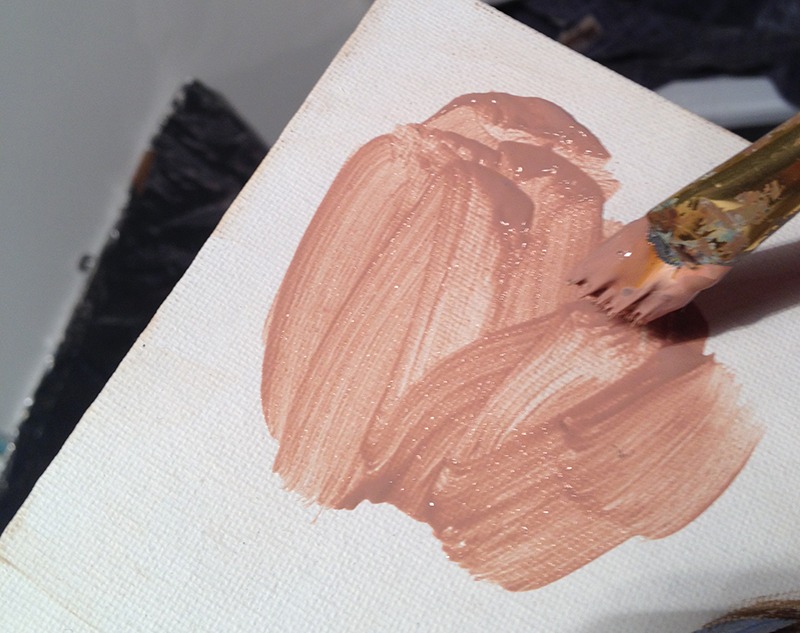
After following the videos two aspects I struggle with
The fine detail … I used a 0 and 1 round paintbrush but still I paint above the indentations in the canvas.
Dark colours create a matrix pattern
i.e. paint on top of indentation nothing in the holes
So fine work is a struggle.
Just wondering if I need to push the paint into the canvas as opposed to brushing?
These are some excellent questions, and they get right into the heart of the acrylic glazing technique. I may need to touch on this more in future video lessons. You do need to push the paint in–actually “scrub” the paint into the texture of the canvas. Here’s how to do it, using a flat brush:
First, get a good amount of paint on the edge of your brush, almost “scooping” it from the pile of your mixture onto the edge of the bristles.
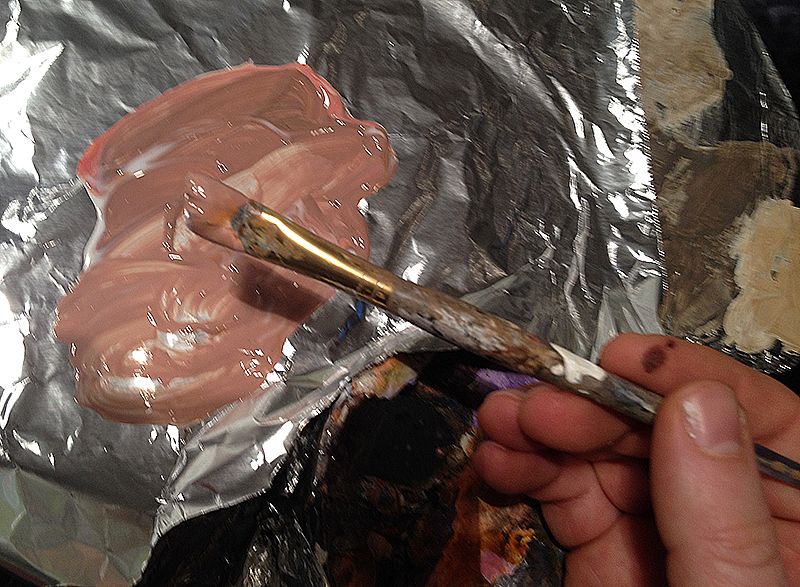
Next, “scrub” the paint into the texture of the canvas, pushing the paint in the grooves with edge of the brush more perpendicular to the surface of the canvas, rather than parallel. You can see I’m using quite a bit of pressure to get the paint into the little holes of the canvas weave.
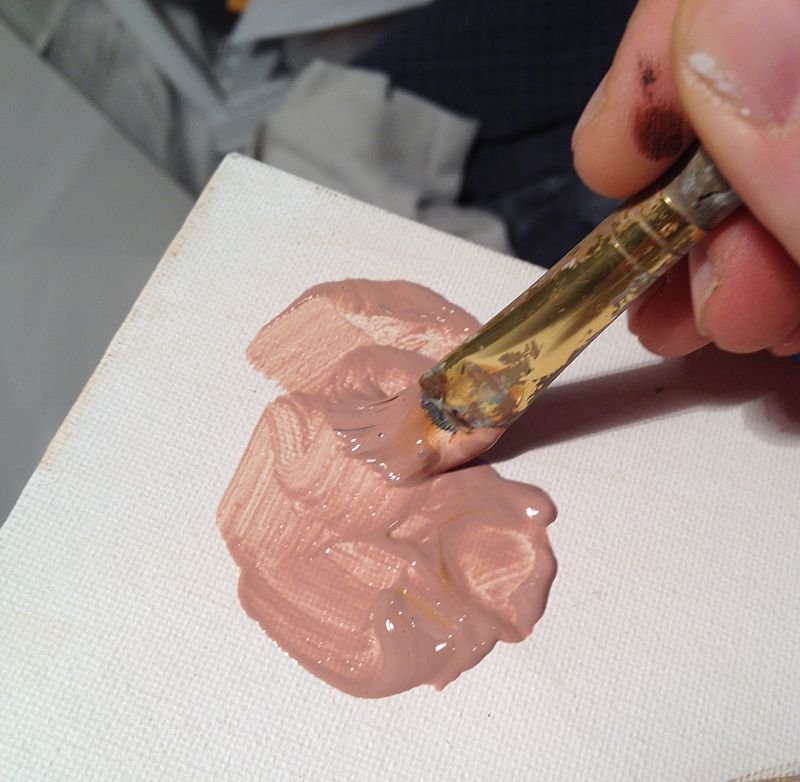
Then, spread the paint out.

After that, even it out with long strokes, applying lighter pressure. First use diagonal. Then go over with vertical.
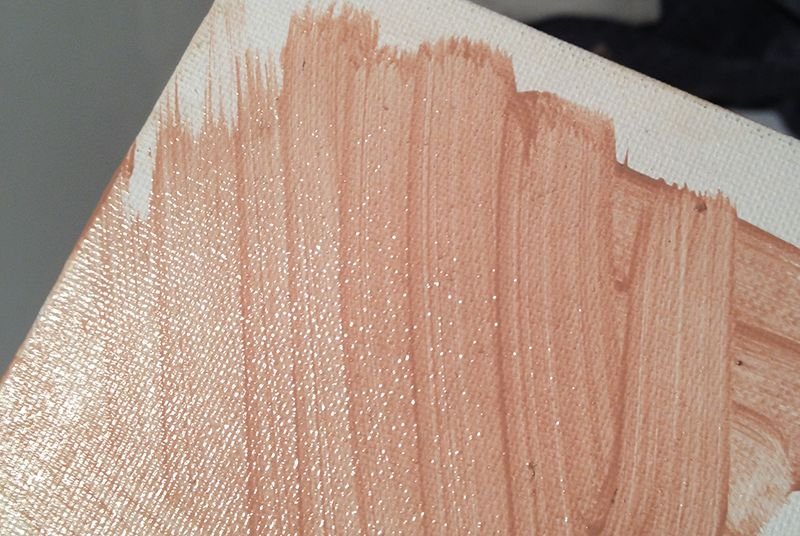
Finally, go over the entire area again with diagonal strokes. You may need to criss-cross them to get an even blend. Use even lighter pressure for this. The trick is to just glide over the surface without digging in too far.
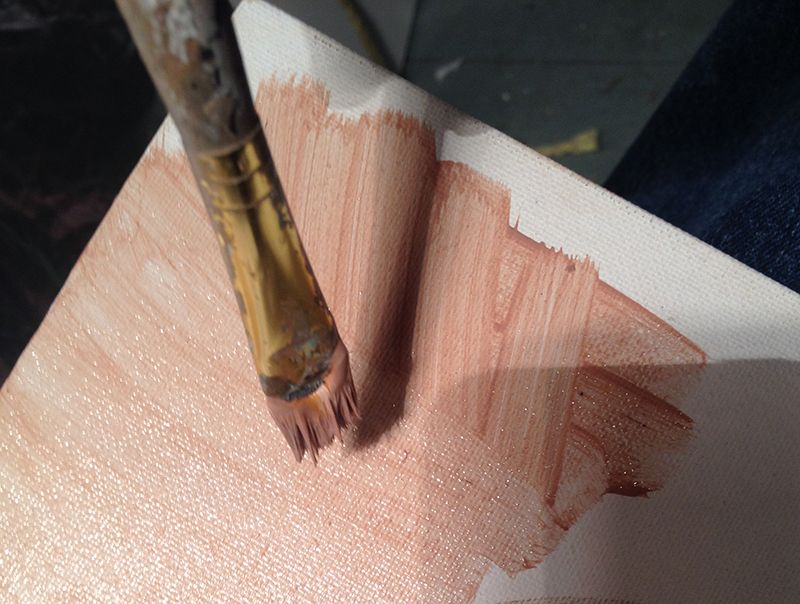
This is how it should look when you’re done.
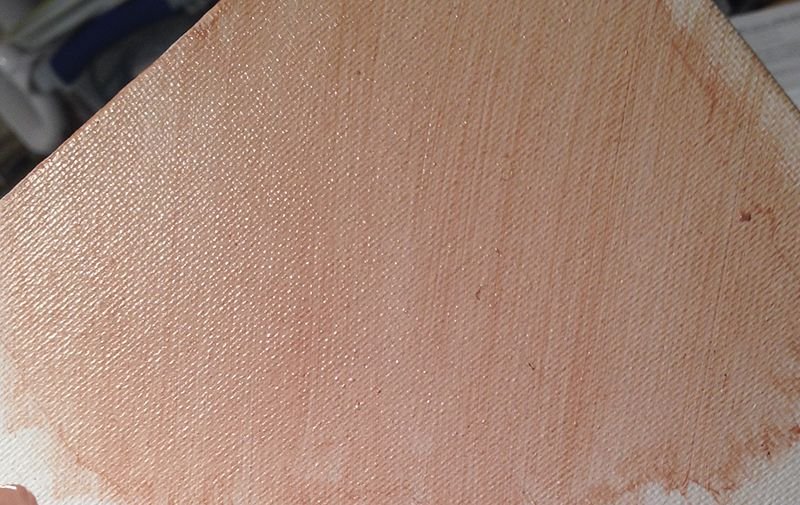
After this layer dries, you can apply more layers, and change the direction of the diagonal strokes to get an even smoother look.
For a small round brush, you can’t scrub or push the paint in. That would ruin your brush or at the very least, lessen your ability to paint precise detail. With that, what you need to do is thin the paint down with a mist of water from your spray bottle and make sure you’re using fresh matte medium in your mix. By keeping the paint fluid it will go into the grooves of the canvas.
However, the glazing technique works even better on a flat surface like hardboard. I love the traditional look of canvas, but sometimes I get tired of fighting the texture and get out a smooth board to work on–especially for smaller paintings.
Let me know how this helps!
Be blessed,

P.S. Did you find this post helpful or encouraging? If so, send it on ahead! Let others know with the share buttons below. I’d love to hear your comments. Thank you so much! Also, do you have a question on acrylic portrait painting you’d like answered? Let me know, and I’d be happy to help!
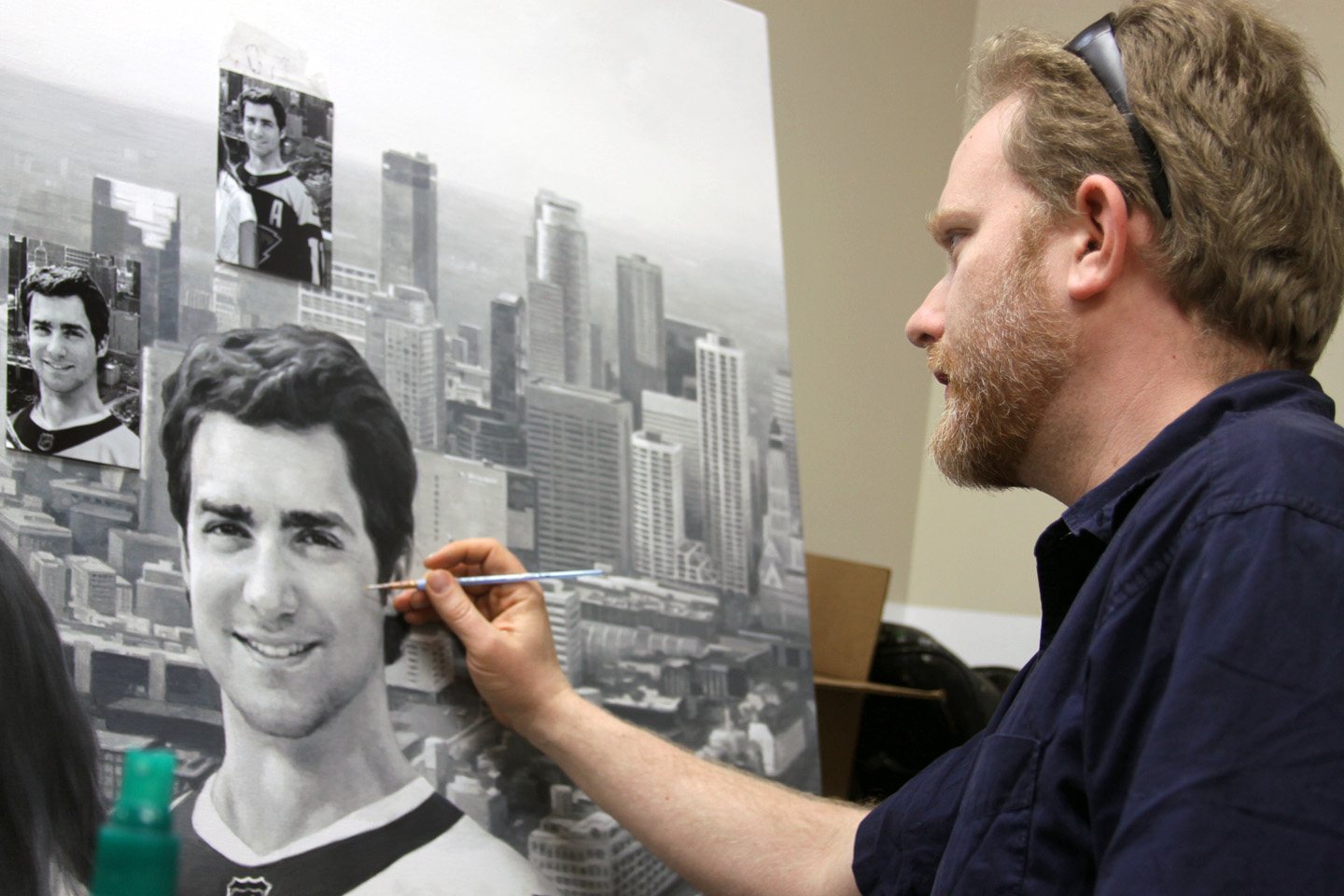
Would we talk about girls and shoot hoops? Or maybe play guitar? (that’s more up my alley)

I had a client who brought that idea to life. It was his idea, actually that he wanted me to paint–a massive 48″ x 72″ realistic acrylic portrait–in black and white– of he and his wife as they looked in their 20’s, along with their two children, who are currently in their 20’s, all hanging out in the same time and place. In the background is New York City, where they were originally from, merging into Minneapolis, which is close to where they and their kids now live.

After meeting together, I got to work putting together a layout of what the painting would look like when finished. It always helps to have a good-looking family to do your painting from! My client kind of reminds me of Scott Baio or Tony Danza in these photos.

During the layout and approval process, I also worked on building the canvas. I started with professional stretcher bars made in the USA, complete with locking mitre joints and beveled edges, and assembled them. It is extremely important to have a strong support for a 4″ x 6″ canvas, to be able to withstand the tension of the stretched fabric, and to keep from warping. I made sure to include cross braces and diagonal braces as well.

Next, I stretched the canvas with pliers and stapled it extremely carefully, measuring every mark to ensure even tension. Just this process alone took several hours.

Finally, the stretched canvas! I apply hot water with a brush to add just a bit more tension and get out any wrinkles. If you tap it, it sounds like a drum!

The next step was to gesso (prime) the canvas. I use a high quality gesso, which is white acrylic paint plus ground pumice to make it sandable. I used three or four coats to get a really smooth and durable surface.

With a blank canvas to work with, I feel good.
It doesn’t feel daunting. It’s like a clean slate, ready to add something beautiful and intricate to. It makes me think of what God does in our lives when He forgives our sins through Jesus Christ, and then we are clean, perfect, and ready for Him to work with us to create a masterpiece!

It was around the beginning of March when I started painting. My client and his family approved the layout after a few changes, and so I was ready to go! I decided to skip the pencil sketch, and get into the painting process right away.
Many people ask me how I do the sketching process. It depends on the project. Most often for small portraits, I freehand sketch them. For a large scale and incredibly detailed project like this on a canvas, I will either grid or project the design with an overhead transparency projector. Canvas is very difficult to sketch on with a pencil. In this case, I projected the design I created in Photoshop, using a small brush and a grey paint to quickly capture the lines of the image.
The portrait took nearly 200 hours to complete, from the time taken to build the sizable canvas stretcher frame to the last dab of paint.
Although it is easier to do a painting this way than full-blown color, it presented a few difficulties that I didn’t foresee, at least to the extent that surfaced in this work.
You would think that to do a black and white painting that you would simply just use black and white paint and mix various amounts to arrive at the grey tones in between.
It didn’t work that way for me.
I typically paint with a translucent glazing technique that allows light to reflect through the canvas and back to your eye through the layers of paint, like the Old Masters, giving the final painting a vibrance that is hard to capture with opaque paint alone.
So, when you mix black with the clear acrylic medium, even mixed with some white, and apply it to the canvas, the resulting color is not slate grey, but a brownish grey, because the light shining through the canvas warms up the color.
Then, when certain areas become more opaque than others, the predominance of white mixed in with layers gives the grey shade a cooler, bluish cast.
Maybe I’m just picky, but I don’t want certain areas of the painting to look brown or blue (at least without my say so) when I’m shooting for black and white. If the client commissions a black and white painting, that’s what he expects to get.
The solution?

I included brown (raw umber dark), yellow (raw sienna and indian yellow), and blue (ultramarine blue) on my palette and mixed it back into the colors to correct anything that was off. If the shade was too cool, I warmed it up with brown and yellow. If it was too warm, I cooled it down with blue.
So even in a monochromatic painting, I still end up using color!
But that’s OK, because color is fun to use. 🙂
Now I did make the background just a bit cooler in tone, so that it would visually recede. But it’s nice to be able to do that, when you, the artist chooses to, not just letting the paint do whatever it wants to.

Next, I painted a glaze over the entire painting, to give me a mid-value grey tone to work from. I add in darker values and highlights, working my way across from left to right. I try to develop the painting as a whole and not get too hung up in any one area.

It took over fifty hours to paint the background. I thought I was making it too dark, and had to constantly remind myself that the subjects, the people in the front would be much darker, with areas of pure black paint, and make the background look lighter by comparison. I wanted to “fix the background” and try to lighten it up, but I kept telling myself, “just wait until you paint the people.”
After finishing up the background, I really honed in on the people in the foreground. Here are some photos of me working taken by a talented photographer, Tom Gardner, at Artisan Forge Studios, where I used to work. At this stage I am nearly finished with the portrait. Yes, I can see the finish line from here!


How often in our lives do we judge something or someone prematurely? We ought to reserve judgment on many things in our lives, and especially in others’ lives, believing the best, and wait until everything shakes out. God has a purpose and a plan that we don’t always see. Things can look horribly wrong, when God is creating something wonderful behind the scenes.
When I finally finished it, hours upon hours later, I was satisfied with the results.

Here is a closeup of the father when he was young…

And then the mother…

The daughter…

And the son…

Here is a detail of New York City, with the Brooklyn Bridge in the background.

On the right side of the painting is Minneapolis, with that recognizable round tower…

The best part of the entire project was to deliver it to the client and later to see it hanging in his home. What a conversation piece!

Hope you enjoyed this post and have a blessed day,

P.S. Did you find this post helpful or encouraging? If so, send it on ahead! Let others know with the share buttons below. I’d love to hear your comments. Thank you so much!

His name was Verlyn. He used to come by my house and he’d have his station wagon full of bread, bakery items and other things that he gave to people in the neighborhood as a ministry.
We developed a nice friendship along the way. His wife was ailing at the time and then sadly passed away. I did this portrait for him last year to help encourage him in his time of loss. He is still going strong, even in his 80’s and after everything, he’s taking care of a disabled man!

Here is the reference photo. I took the liberty to lighten up the background and change it to a more neutral color. Also, I brought the two of them a bit closer together, so I could give the portrait an aesthetically pleasing vertical orientation.
And now for the step-by-step process…
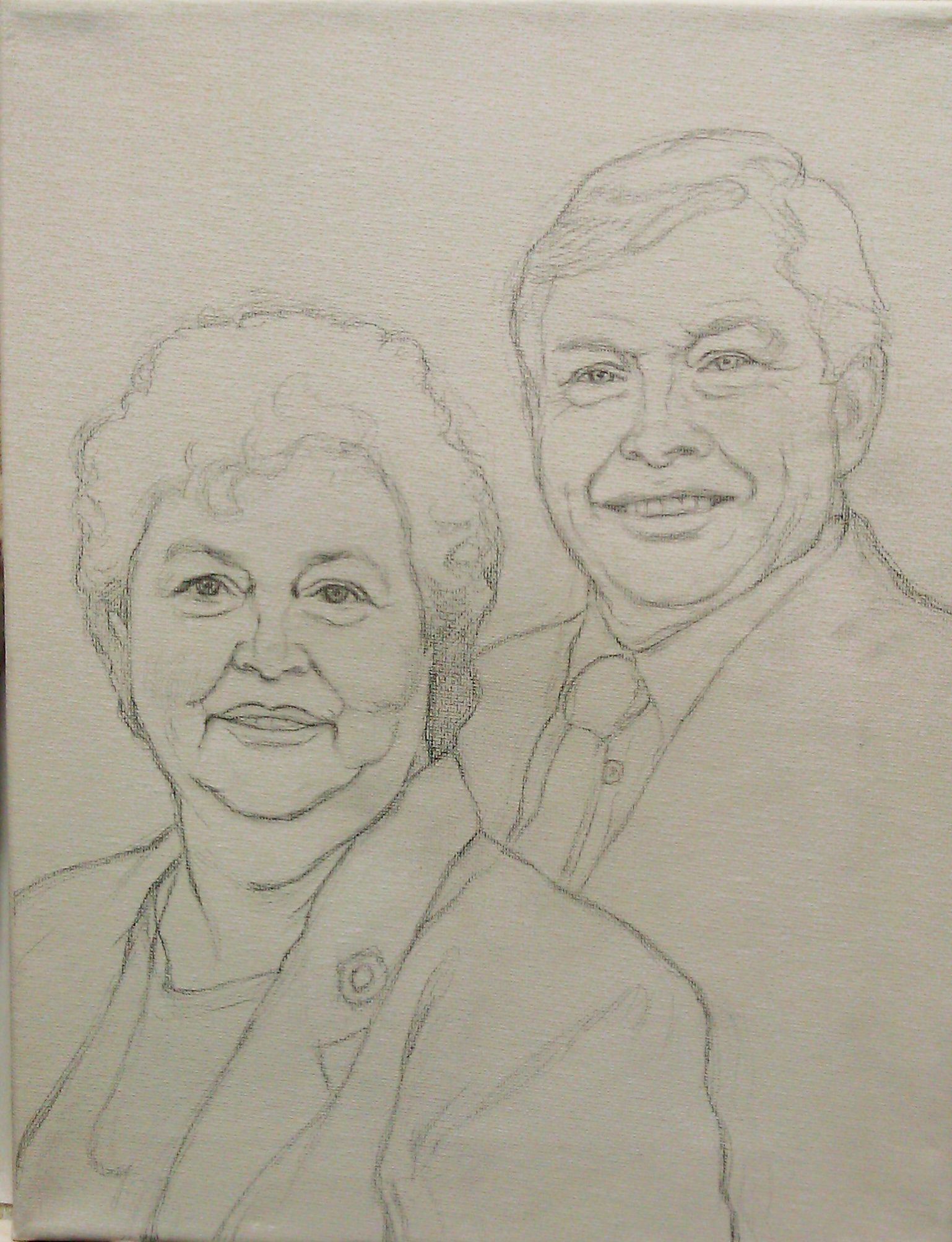
This was done freehand. In this stage, I try to get it as accurate as possible, so I have a good foundation to build my painting upon. But there are inevitably a few things that may be off, that have to be addressed in the painting stage. And that’s OK, because with paint it is easy to make corrections. Usually, I sketch in colored pencil, but I think, looking back, I might have run out of them and so used a graphite pencil, even though it is harder to work with.

In this stage, I start by adding some light layers of color: ultramarine blue mixed with raw umber dark, and a alizarine crimson. I like to start my paintings with just one or two different colors and then build from that. So, even though he has pink hair for now, I’m not going to worry about it! The goal is to quickly separate cool hues from warm, and get the values blocked in quickly to build up depth.

Meanwhile, I keep darkening the background with a mixture of raw umber dark and ultramarine blue to make grey. All of these layers, by the way, are thinned down with matte medium and applied with the glazing technique to give the painting richness and depth.
Would you like to learn how to do this technique? Get my free video lessons below…
Learn How to Paint Acrylic Portraits With My Free Mini-Video Course!
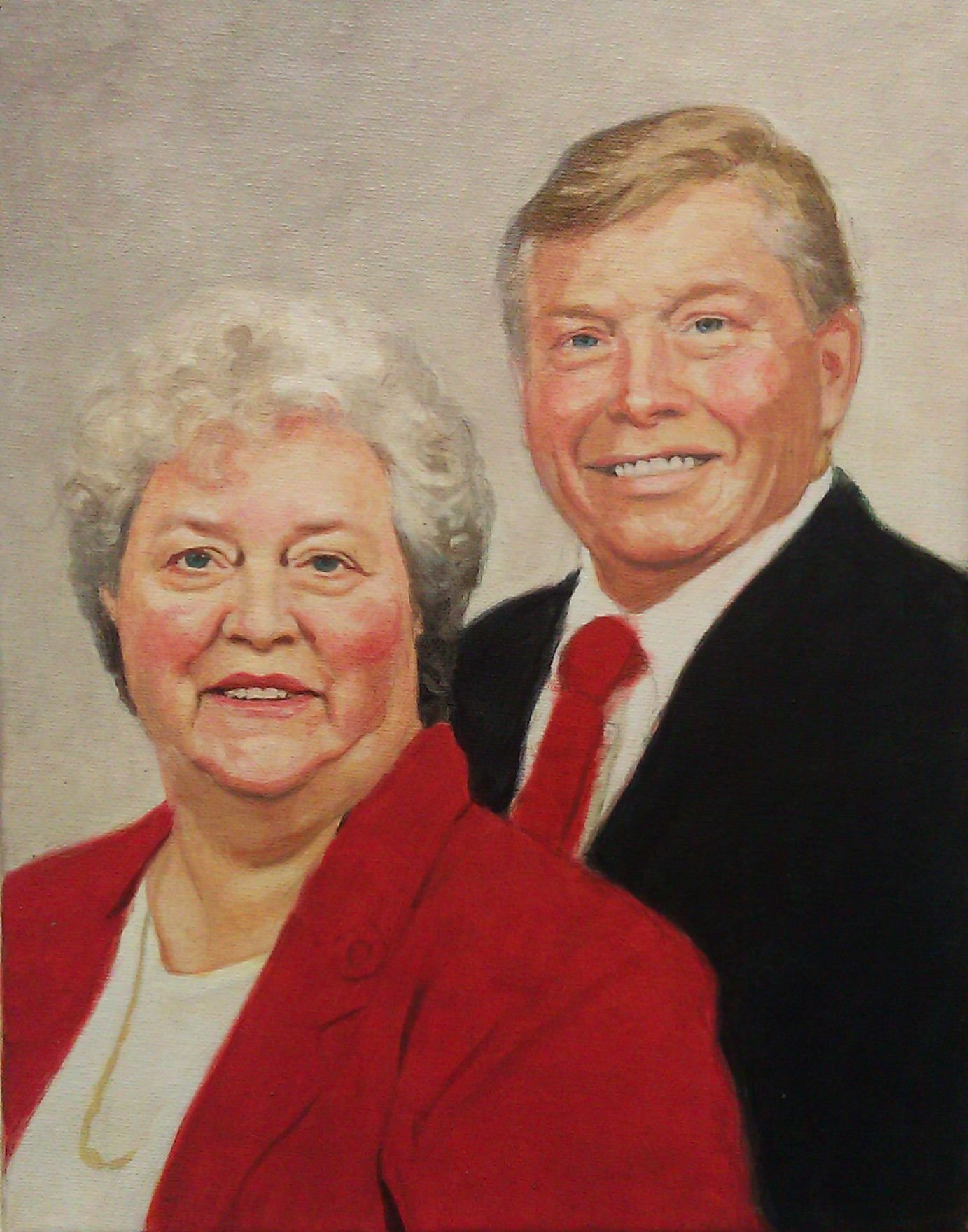
At this level, the colors are getting very intense, but there’s still a lot of nuances to add yet, to smooth out the major shaded areas of the face. It’s important to remember that your sketch can’t capture a likeness as precisely as a full-shaded in portrait. The subtleties of values sculpt the dimensions of the face.
So when you’re sketching, cut yourself a little slack if you haven’t captured the likeness perfectly. Just get it close.
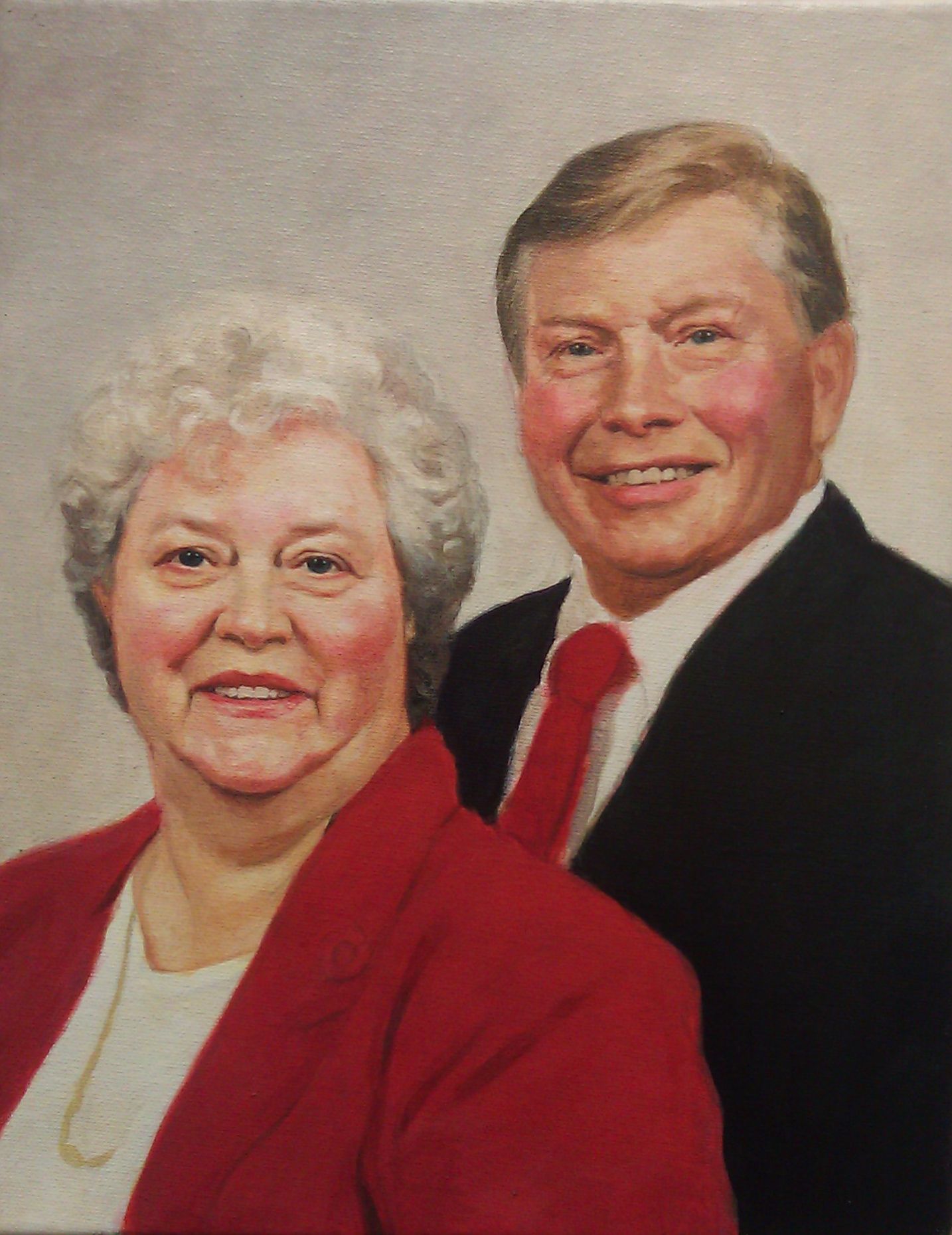
It’s starting to look closer, but there’s more details work to be done. As you can tell, the pin on the woman’s lapel can be seen, faintly under the glazes. It’s time to paint it in. And there’s more work to do on the man’s tie–shadows on the edges that will give it depth and make it look like it’s really there, resting on his shirt.
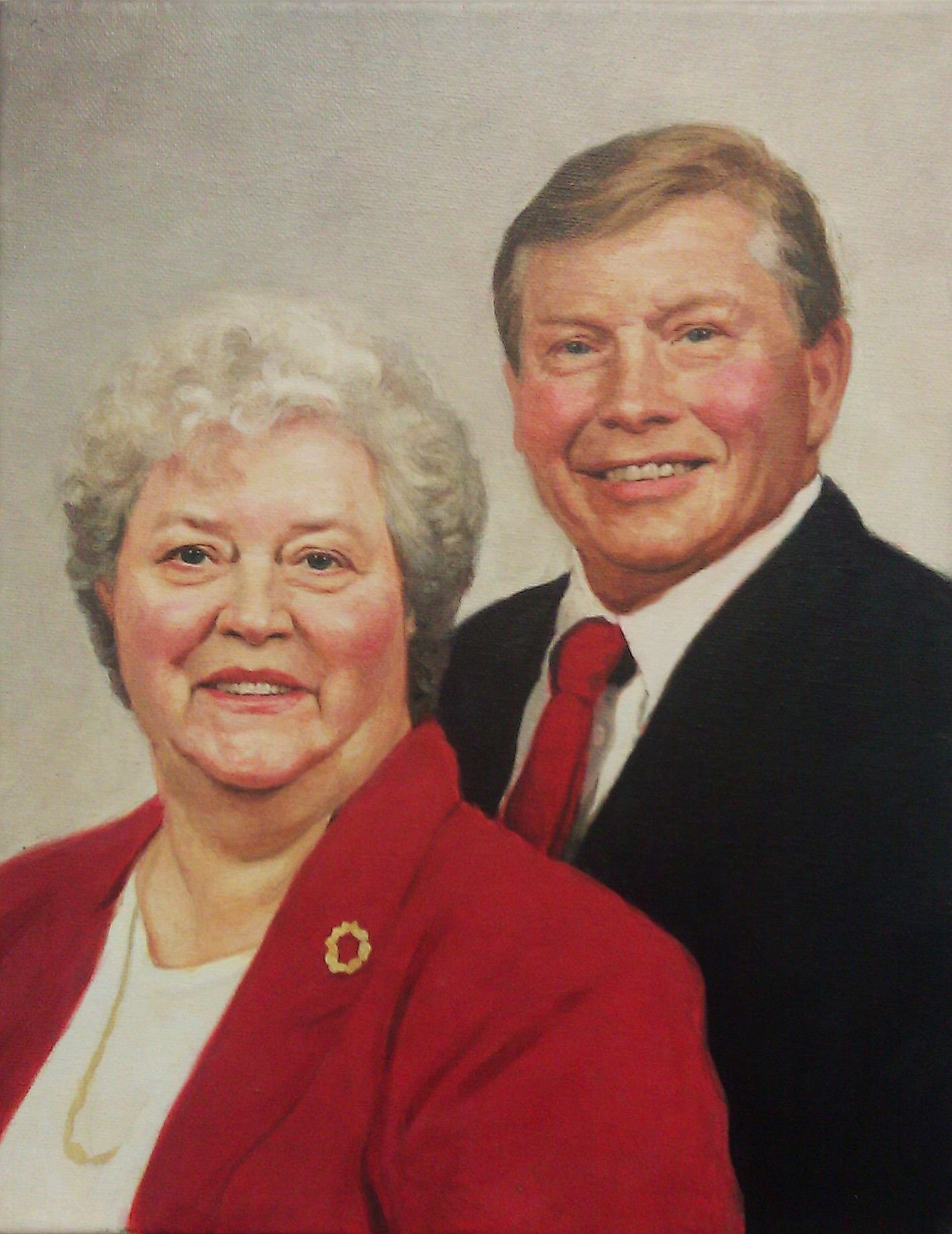
I feel like I’m in the home stretch at this stage, where I could call this finished, but there’s just a few final details yet: The details on the woman’s necklace, the tie-in values (where you take sharply defined shadows and merge them into smooth gradations) on the man’s tie. Highlights on the faces. And even just a few spots on his forehead to give him some character.

Done! All in all, this painting has dozens of layers of translucent paint and over 25 hours of work put into it. It was worth every minute. My friend really appreciated it, and it brought a lot of encouragement as it helped to keep this memory alive.
Let me know what you think of this mini-tutorial, and how I can improve these for you in the future. Share your paintings with me anytime and let me know how I can help you become a better artist.
Be blessed in your painting,

P.S. Did you find this post helpful or encouraging? If so, send it on ahead! Let others know with the share buttons below. I’d love to hear your comments. Thank you so much!
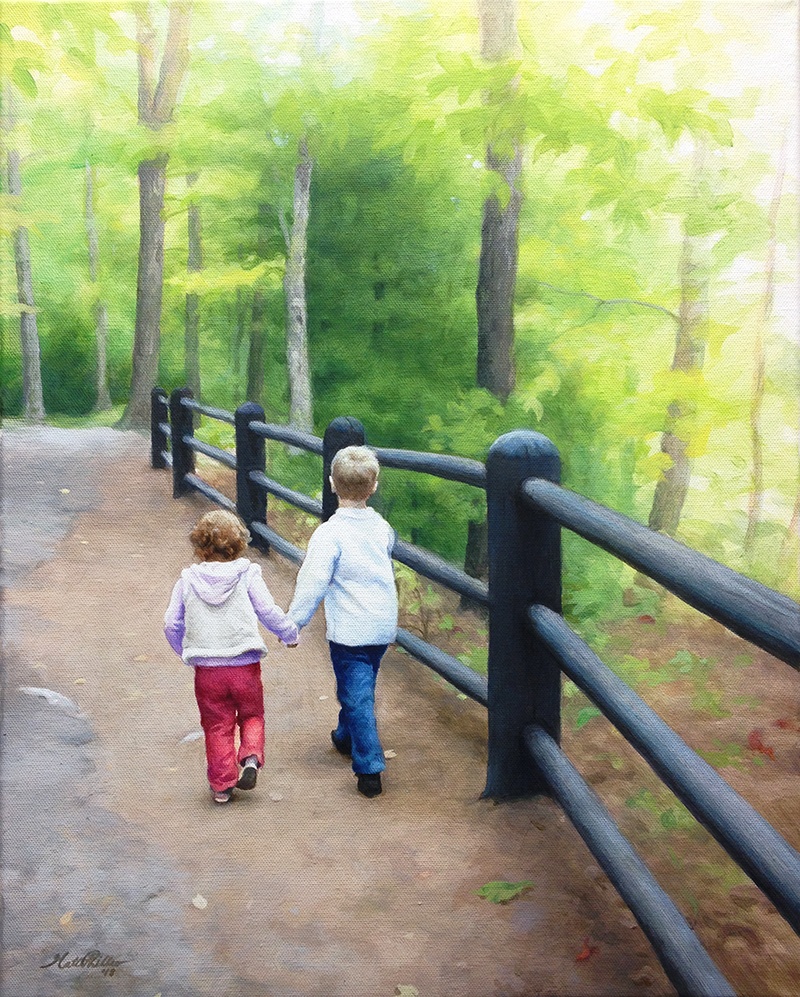
It will be used for a book cover illustration of Charles Spurgeon’s Devotionals for children. Below I want to do a recap of my previous posts from Facebook and Steemit, showing you the process of how I did this painting.
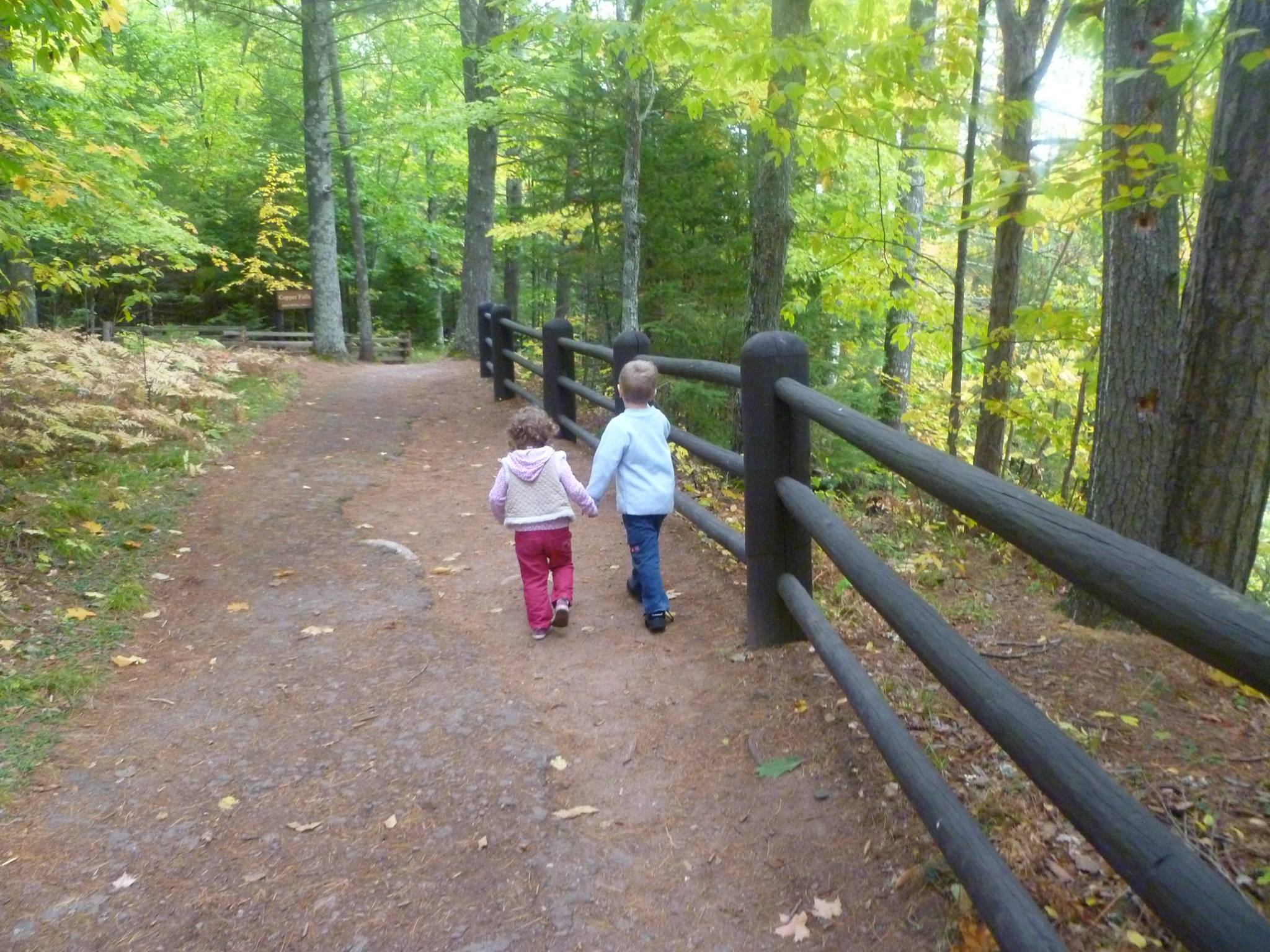
I start off very faint, just blocking in the colors with glazes. I mix about 90% clear acrylic medium to about 10% paint and just block in the composition, suggesting where the future colors will go. Here is my palette…
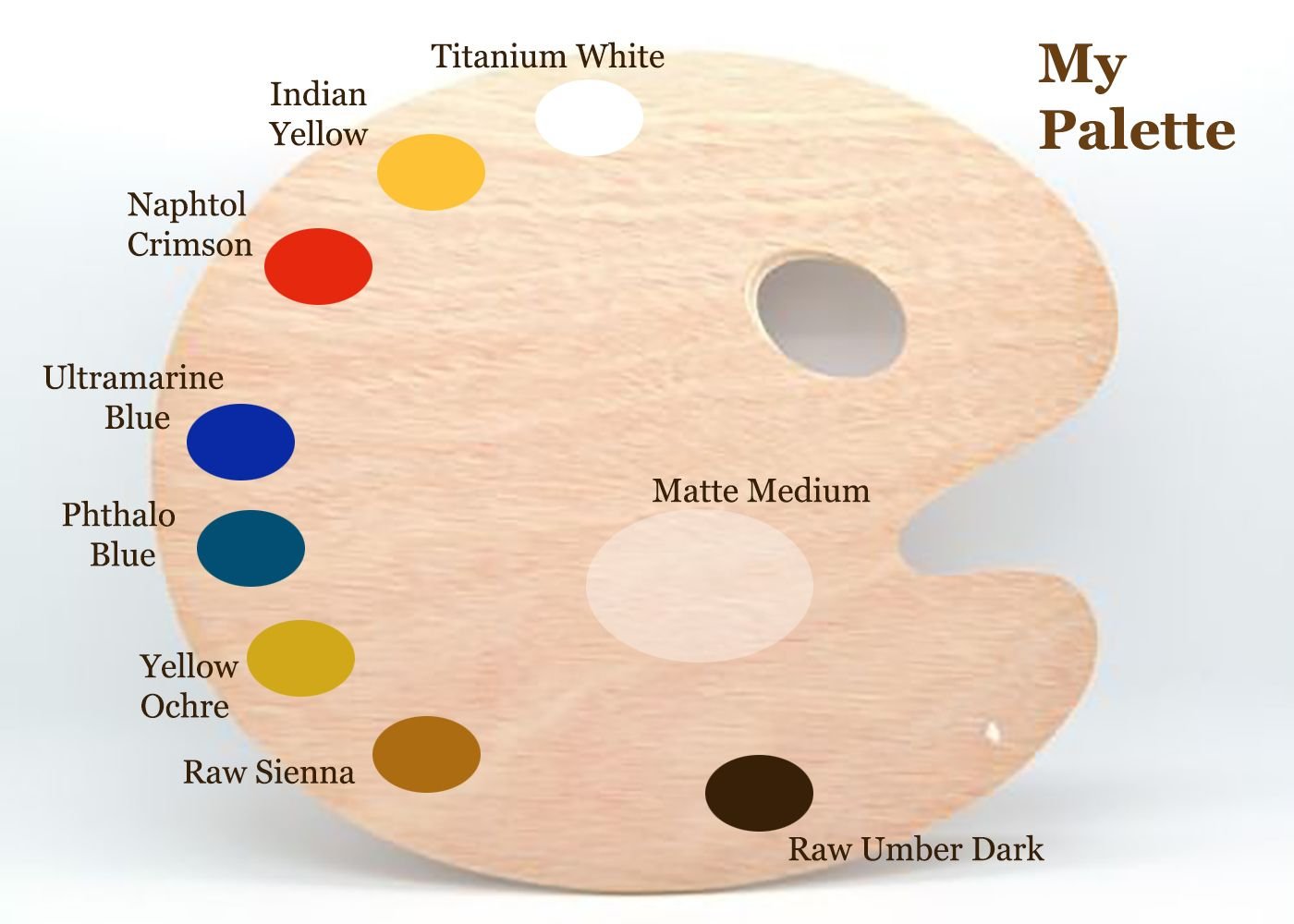
Normally, I use burnt sienna, but to challenge myself and also to enhance the color harmony within the painting, I omitted it.
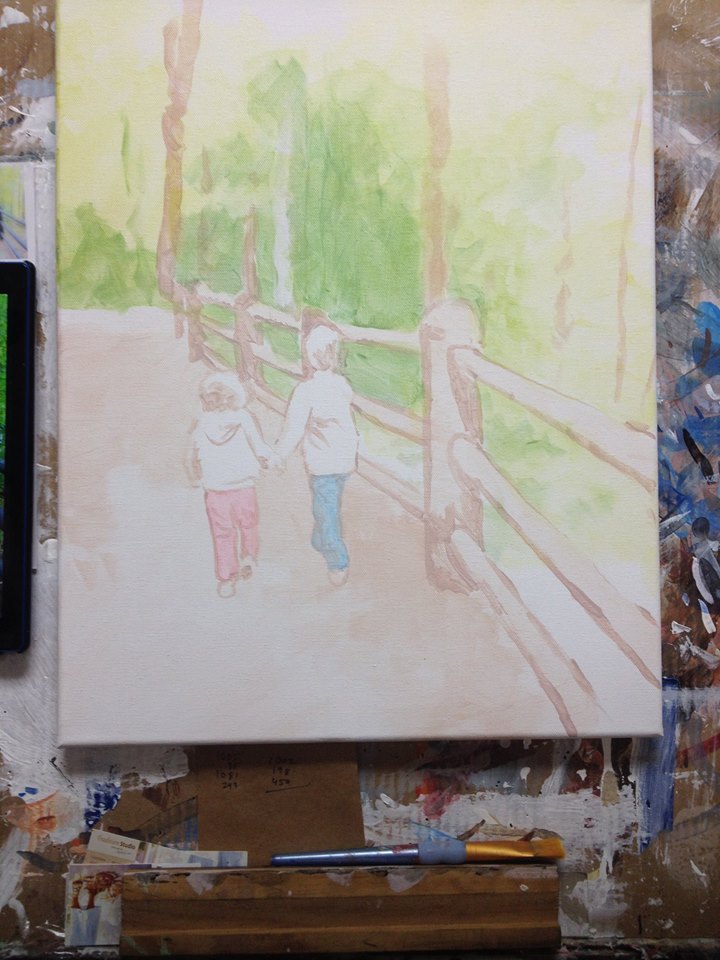
The first layers consisted of raw sienna, yellow ochre, phthalo blue and indian yellow for the background, and then for the posts: raw umber dark, ultramarine blue and napthol crimson. I blocked in the blue jeans with phthalo blue, and my daughter’s pants with napthol crimson.
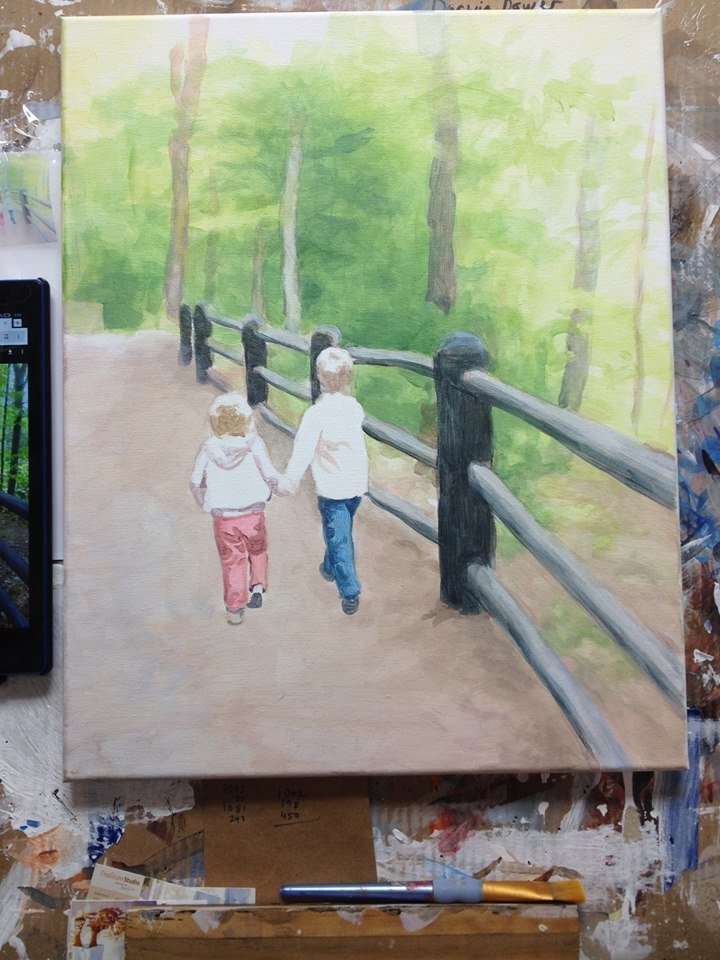
In this step, I added some phthalo blue, raw sienna and yellow ochre in a glaze to the background to suggest trees, and went over the trees with some raw umber dark, napthol crimson and ultramarine blue.
In this step, I added in more layers of green to the background, and filled in the colors for both kids’ pants. I also added in some shadows as well below the fence posts and filled in the shadows a little deeper and more dramatically.
I added some more detail to the background and shading to the children, especially my daughter’s hair. Overall, since I use the glazing technique, I incrementally darken the entire surface, bringing out more details and nuances by “pushing and pulling” the paint: darkening certain areas and lightening others.
With the winter weather we’ve been having in Wisconsin, a walk on a warm day like this picture looks pretty good.
I’m almost done with this painting: I added some contrast to the posts, more nuances within the clothing, some fallen leaves, and some darker areas within the trees in the background to tie the values in with the posts. Still not quite there yet.
I’ll need to substantially darken the overall value of the background to match the much darker and more vivid foreground. Sometimes creating art can be a balancing act. But it’s much safer than being on the high beam!
In the final rendition, I darkened the values in the background, to tie them in with the very dark posts of the fence, and even the shadows on the children. I also added a few details to the children’s hair, and highlights to edges of the clothing to make them stand out more. Lastly, I put a few more glazes of raw umber dark, ultramarine blue, and titanium white for the trees.

This painting took about 20 hours to do. It was my pleasure going on this journey with you, showing the process, and maybe even help you to think about warmer weather at a time when many of us are ready for spring!
Be blessed in your painting,

P.S. Did you find this post helpful or encouraging? If so, send it on ahead! Let others know with the share buttons below. I’d love to hear your comments. Thank you so much!